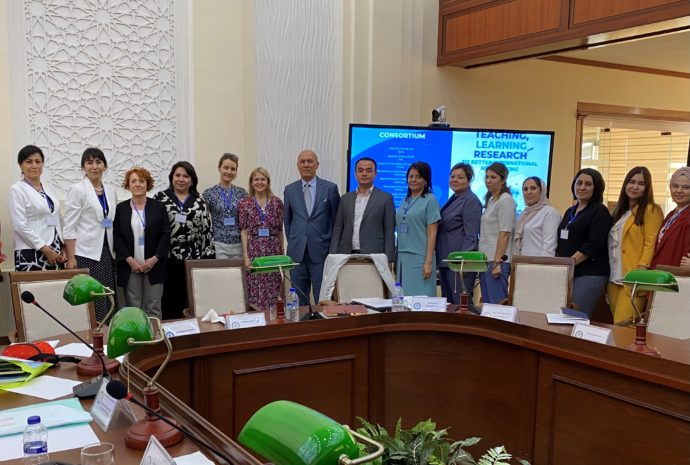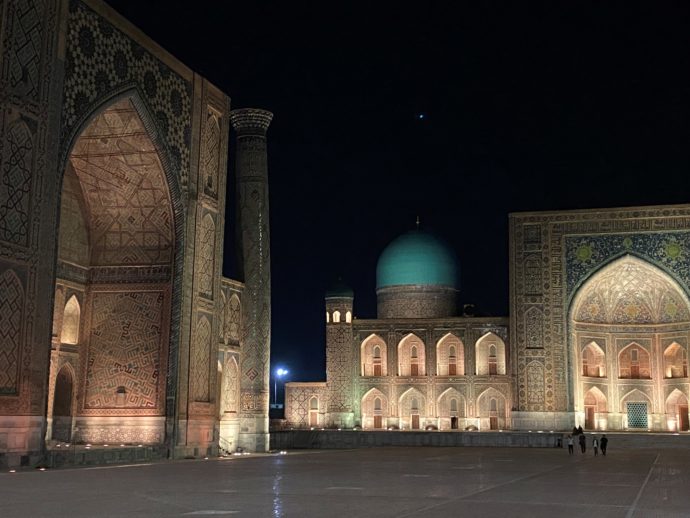“Wow, that sounds really exotic and exciting! Where is that?” I heard numerous times when telling my colleagues and friends about my travel plans for Tashkent, the capital of Uzbekistan. The comment reveals that Uzbekistan is quite unknown among Finns. The country is, however, the biggest and mightiest of all Central Asian countries, with 34 million inhabitants speaking mainly Uzbek and Russian languages and being mostly Sunni Muslims (Uzbekistan). The stereotypical perception of a Muslim country does not apply to Uzbekistan, though, as the country is secular. It is a country of millionaires: 1000000 local soms equals 85 euros, so exchanging some hundred euros to soms made me a millionaire, too!
Excited I certainly was when I got the great opportunity to mobility in Central Asia in April 2022 through UNICAC project. In this paper, I aim to offer a peek into Uzbekistan by sharing my experiences, both as a representative of a university and as a tourist. I hope it inspires and encourages personnel and students to participate in projects and apply for a mobility in Central Asia.
Internationalization in focus
Uzbekistan has a strong desire to develop and internationalize. Influential global funders like the World Bank and the European Union as well as individual countries finance diverse development programs on all fields of society. Education is one of the sectors receiving funding for modernization and internationalization. According to a “Concept of Development of Higher Education of the Republic of Uzbekistan until 2030”, at least 10 universities of Uzbekistan should have an international rating, thus the country`s educational sector is determined to strengthen international relations with developed countries to enable wide application of international standards and activities in the higher education system (Uralov 2020).
My mobility to the National University of Uzbekistan was one of the internationalization activities of UNICAC project. This 3-year project receives funds from the European Commission through the Erasmus+ programme and it aims to increase the potentials for international and cross-regional cooperation within higher education in Uzbekistan, Tajikistan and China together with partners from Finland, Spain and Italy, through various capacity building activities for International Relations Offices (UNICAC). The International Relations Office of the receiving university had drawn up a program that enabled to reach the objectives of the mobility: getting to know the university staff, activities and facilities as well as the surroundings, communicating with students at teaching sessions, strengthening relations between the project partners and exchanging ideas for further collaboration.
From the UNICAC consortium, there were lecturers and students from Italy and Tajikistan, too, participating in the mobility week. During the mobility, we had a good opportunity to get to know about each other’s countries, cultures, higher education systems and best practices in internationalization. Versatile presentations at a seminar enlightened well educational realities of the participants. I had an honor to speak in a conference with the country`s Ministry of Higher and Secondary Specialised Education and National Erasmus+ Office represented. The audience that consisted of vice-rectors and of representatives international relations of all universities in Uzbekistan, appreciated Laurea`s competence-and student-centered pedagogy, and its dynamic international activities and networks. Finland`s good reputation in the field of education was familiar also to the Uzbek students with whom I had conversations in classrooms. Many expressed their interest in mobility abroad.
 UNICAC conference gathered participants from Central Asia And Europe in National University of Uzbekistan.
UNICAC conference gathered participants from Central Asia And Europe in National University of Uzbekistan.
(From travel album of Elina Wainio)
Exploring the country
Uzbekistan is not only promoting intercultural university cooperation but is also aiming for internationalization in many other fields, like tourism. By restoring historical sites and improving infrastructure and services, the country wants to attract more foreign tourists. As a foreign visitor myself, I could honestly tell there is a lot to see and experience.
The most impressive thing when meeting Uzbek people is their hospitality and courtesy. Supposedly it is characteristic of the Central Asian culture of which I had gained my first experiences on my visit to the neighbor country Tajikistan a couple of years ago. In all encounters with the locals, respect and appreciation were verbally and non-verbally expressed which created a favorable atmosphere for communication. Uzbeks were also tremendously helpful; even in situations where there was no common language to be used, I always succeeded to get help and support. The unique local customs and traditions of Uzbek hospitality are deeply rooted within its people making visitors feel comfortable and safe (Olimovich 2015).
Uzbekistan has a superb historical and cultural heritage that has been shaped by various civilizations and epochs over the millennia. Visiting the ancient settlements, mosques, madrassahs, palaces and mausoleums and bazaars offers a great opportunity to experience the silence of the distant past but also the living history. (Olimovich 2015).
It is no wonder that the tourism site Uzbekistan calls the country The Jewel of Central Asia, as it is a stunning blend of Oriental and Soviet eras, old traditions and modern marvels. As three of the most important trading stop-offs of the Silk Route are in Uzbekistan, the legacy of the ancient route can still be seen and sensed in decorations, breath-taking mosaics and ceramic ornamentations decorations, grandiose domes and minarets as well as in gorgeous handicrafts and pieces of art. (Uzbekistan.) The Soviet era threw its distinctive layer into architecture and urban design with concrete buildings, broad avenues and grand parks, being followed by imaginative modern times structures with technological solutions.
In Tashkent, the capital, the past and the present meet vibrantly. It was interesting to explore its different quarters, each having a peculiar ambiance. At the immense Chorsu Bazaar the locals buy everything from live hens and fresh vegetables to carpentry furniture and brand clothing replicas. There I could really feel authentic hustle of bargaining! Quite the opposite was Tashkent City Park and Magic City Park, whose imaginative buildings, illuminated and dancing fountains were like in Disneyland. The capital had also a great offer of high-grade cultural events. I enjoyed a marvelous classical concert, an opera at the famous Bolshoi theatre and an entertaining circus with Mongolian performers. Ticket prices for all events were only a fraction of the prices in Finland. It was the same with the food prices: two persons could enjoy a dinner for 5 euros, including the national rice-meat dish plov, some salad and bread with tea for drinks.
It was easy and almost free to travel by metro, the stations of which were attractions themselves; some as decorative historic halls, others more like space stations. Taxis were an inexpensive alternative, too, especially if ordered in a mobile application. Travel by train was also inexpensive and smooth, as proven on our excursion to Samarkand: a handy railway app sells tickets that include a nice snack, and the tidy trains run on time.
The beauty of Samarkand was incredible! No wonder it is on the UNESCO`s world heritage list. Founded in the 7th century B.C., Samarkand was a crossroad of the world’s cultures, and its architecture is a masterpiece of Islamic cultural creativity (Samarkand – Crossroad of Cultures). The old town Registan Square with its majestic madrasas -Islamic schools- and other ancient monuments were simply magnificent with their decorations glistering in bright blue, turquoise and gold. Registan`s ambiance and the locals were truly pleasant, from handicraft and souvenir vendors to families running cozy hostels and restaurants. Samarkand is definitely the place worth visiting once in a lifetime!
 Ancient madrassahs, Islamic schools, at Registan Square in Samarkand.
Ancient madrassahs, Islamic schools, at Registan Square in Samarkand.
(Photo taken by Elina Wainio)
Conclusions
Internationalization is imperative to higher education institutions throughout the world. It is beneficial to universities as it enables knowledge transfer and acquisition, supports global research, improves the academic standard as well as enriches education and curriculum with international content. In addition, internationalization supports promotion of institutions and diversity of faculty and students. International project funding plays a focal role in creating academic consortiums that execute concrete internationalization actions, like research projects, development assistance and mobilities. Especially in developing countries, international capacity-building projects in the field of education can have a huge impact on the development of society.
Through academic exchanges, university staff and students can gain, improve and distribute their intercultural expertise and competences that are vital in the world of work. On a deeper personal level, exchanges can widen one´s worldview and perspectives, and thus increase intercultural understanding and tolerance, dialogue, cooperation and interpersonal relationships. During an exchange one can immerse her-/himself into another country, culture, people, society and traditions, and at the same time make those of hers/his known to the others.
I am no longer a millionaire if measured with soms. But I feel like a billionaire if measured with new colleagues and friends, professional inspiration as well as enriching experiences and everlasting memories gained through the mobility.
References: